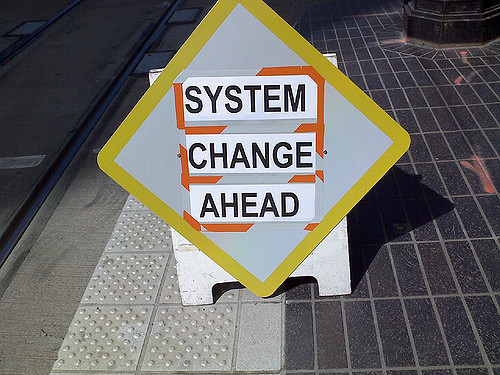
~
In my own mission to realize my vision of the world and in my work with many visionaries over the years, I see that we believe in global transformation. We feel called toward a conscious evolution of the world, specifically into one that’s more compassionate, expansive, harmonious, and just.
And yet, so many of us lose faith, steam, or traction as we try to carry out this calling.
When I look at what is going on in our world, what I see is a wavering between what we’ll call an “old” consciousness—a worldview rooted in fear, judgement, scarcity, separation—and a “new” consciousness based on love, compassion, abundance, and harmony. The old is feeling the pull of the new, and is now doing as much as it can to resist it becoming our new paradigm.
Because it is new, many of us who champion this upgraded consciousness are unclear, uncertain, or misguided on how to bring our visions, and our manifestations of those visions, to life.
Reflecting on what has and hasn’t worked in my experience (and throughout history), a certain set of principles keeps surfacing. I l hope that at this crucial time, those of us who are called to enact this new vision of the world will use them as a guide for seeing it through.
Be unrealistic.
As visionaries, we take pride in and apply our intelligence, experience, and creative abilities toward our visions. We dedicate ourselves to reimagining an old system—or an entirely new creation—and to making sure the new vision is viable, workable, and sustainable amid uncertainty. So when we hear “unrealistic,” especially from esteemed figures in our fields and communities, or the intended audiences we’re looking to serve, it can trigger underlying doubt and become demoralizing if not addressed.
We need to trust ourselves and our fundamental creative impulses. We have to remind ourselves of the time and energy we’ve spent in fleshing out and tightening up this vision in light of having no precedent, model, or examples.
As intelligent, wise, and creative people, we wouldn’t have made that investment if we didn’t believe the vision was possible and worth it. It is precisely because it hasn’t been done before that many can’t see what we can see. They shun the vision and meet us with cutting pushback.
Despite not being able to look at history for examples that our particular visions will materialize, we still have history on our side. Those who’ve created new thriving systems and made the dysfunctional old ones obsolete, those who’ve carried out revolutions, those who’ve ascended to the highest positions at organizations, companies, and nations in unprecedented fashion—they’ve all been met with this “unrealistic” backlash.
Yet, as history shows, they’ve made their visions real—and thus, realistic.
Get wise on disagreement.
It is in our nature to make sure the vision is tight. That we’ve covered every angle, challenge, and ambiguity that shows up. Although this may embolden our convictions, we need to be wary of becoming defensive in fear of criticism, misunderstanding, or public attacks. We run risk of depleting our time and energy, trying to imagine every possible form of opposition we could face and every possible defense against the hypothetical opposition.
What’s worse, we run risk of not proceeding with our visions at all as a result.
The key here is to discern which forms of opposition we’ll entertain. There is criticism that points to flaws or blind spots, which helps us refine our visions. There’s also criticism that sheds light on other approaches and ways of envisioning the world which (despite clashing with ours) expand the world with possibility.
And then there’s the criticism with the sole intention of squashing the vision simply because the detractor doesn’t have one. The critics make erroneous assumptions, or resist change entirely. If there’s a lack of civility and substance being brought to the table in return, we can leave them where they are.
Bottom line: People are going to respond or react to our visions when we share them, but we are not responsible for the ways in which they do. Should we choose to entertain them, we must choose wisely.
Beware the allure of the old.
It can be quite tempting to throw personal attacks when we’re being met with personal attacks. It can be hard to resist using intimidation when force seems like the answer at the time.
New consciousness, however, will never thrive playing the old consciousness’s game. Using fear, shame, and force to evolve a paradigm rooted in fear, scarcity, judgement, and separation into one of love, abundance, compassion, and harmony is not logically or ethically possible. While it may appear to work in the short run, often exemplified by a perceived “win,” it is never sustainable and often short-lived.
If we want long-lasting shifts in consciousness, it’s going to take a real commitment on our end to evolve a new consciousness with new tactics and ways to respond (not react) to old tactics.
It demands that we embody the vision.
Discern between awareness and “stuckness.”
It is necessary to develop an awareness of the issues we’re trying to fix or solve when fleshing out our visions. Much of, if not all, the time the awareness is what leads to our having the visions in the first place. We want to be in the know about the injustice, inequality, inefficiency, and overall dysfunction that exists for the sake of our visions. We want as much information as possible about what we’re trying to reimagine or evolve to ensure the viability, workability, and sustainability of the vision.
We have to be mindful, however, of just how much we get caught up in the problems, and lose track of the solutions or intentions our visions hold. Awareness begets confidence that we’re priming ourselves for the vision. “Stuckness” begets deflation and overwhelm. We can focus on what’s wrong to the point that we lose track of what we know in our core is possible. It’s here that we feel the density of the problems so much that we get stuck in them, and lose the prime opportunity to move on and soar with our visions.
Keep attention on intentions.
Instead of getting stuck in the problems, we can use them as a springboard for the development and realization of the vision. That’s why it’s incumbent upon us to keep our visions front-and-center at all times—not the problems. Whenever the going gets rough (and it will) we need to summon the intentions embedded in our visions to strengthen our resolve and strategy in seeing them through.
The election of a president who seems hellbent on keeping old consciousness in place, for example, could dishearten the conscious visionary, especially with all the gains toward having a more progressive system in recent years. Yet, instead of dwelling in disappointment, one can use the contrast between what they want and what’s happening to pivot back toward the vision of what our society would look like based on love, abundance, compassion and harmony, as well as how to best get there. Attention on intentions helps the visionary stay in the vision, which is crucial in moving it forward.
Pause.
In times of adversity, we’re constantly told: “We can’t afford to mourn,” and “we don’t have time to rest.”
To the contrary, we can afford to mourn; we do have time to rest. In fact, we must pause and allow whatever we’re feeling to surface and take a healthy dose of restoration. It enables us to accept where we are, process what is happening outside and inside of us, refresh and regroup, and proceed with wise action—an absolute must in realizing our visions.
The more we resist what comes up for us as we work toward carrying out our visions, and the more we resist our need to nourish and restore our minds, bodies, and souls, the more it will show up in obstructive or destructive ways. When we don’t pause, we run on a depleted tank of gas, not having enough to carry out the full journey of our visions. We don’t have enough patience, compassion, passion, and drive to see our visions through. We become susceptible to avoiding the unpleasant feelings that arise by numbing with various substances or actions, or lashing out in ways that are incongruent with our visions, needlessly setting us off our paths.
It is precisely the kind of self-acceptance and self-care derived from pausing that makes it actually part of the work to carry out the vision, not a departure from the work.
In short, bringing this paradigm-shifting vision of the world to life is no small feat. What it asks of us is a rigorous commitment to personal and world transformation that’s not for the faint of heart. But those called to the undertaking are not faint of heart. We are champions of possibility—boldly proclaiming who we are and what we’re capable of with tremendous heart.
Let’s continue to answer the call to forge a new path for our world.
~
~
~
Author: Delilah De La Rosa
Image: Evan Kirby/Unsplash
Editor: Danielle Beutell
Copy Editor: Catherine Monkman
Social Editor: Yoli R








Read 0 comments and reply